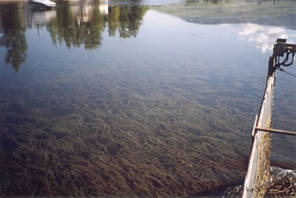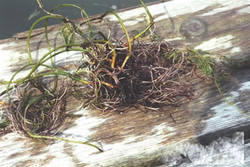 Eurasian watermilfoil (Myriophyllum spicatum) is a rooted submersed plant inhabiting the shallow waters of lakes in British Columbia and other parts of North America. The species is said to have been introduced from Eurasia in the late nineteenth century, likely in ship ballast, though the first documented occurrence was in 1942 in a pond in Washington, D.C.
Eurasian watermilfoil (Myriophyllum spicatum) is a rooted submersed plant inhabiting the shallow waters of lakes in British Columbia and other parts of North America. The species is said to have been introduced from Eurasia in the late nineteenth century, likely in ship ballast, though the first documented occurrence was in 1942 in a pond in Washington, D.C.
Eurasian watermilfoil is very aggressive and once introduced to a waterbody will displace native aquatic vegetation in a couple of years. In the Okanagan, Eurasian watermilfoil was first identified in the Vernon Arm of Okanagan Lake in 1970. By 1974, the plant was well established in all of the mainstem lakes of the Okanagan.
The plants form thick underwater stands and dense mats on water surfaces. Colonization of new sites occurs by vegetative fragmentation as the plant develops auxiliary buds that separate at the node. Some auxiliary buds have root development even before detaching from the parent plant, allowing new plants to establish quickly. In the summer, stem fragments break off, assisted by natural or man-made wave action. Once established, eradication of the plant is almost impossible.
 The maximum depth where rooted plants are found will vary with the depth of light penetration; for Eurasian watermilfoil in the Okanagan this is typically about 5 to 6 metres deep, with some plants found up to 8 metres deep.
The maximum depth where rooted plants are found will vary with the depth of light penetration; for Eurasian watermilfoil in the Okanagan this is typically about 5 to 6 metres deep, with some plants found up to 8 metres deep.
Eurasian watermilfoil is well adapted to rooting in a variety of substrates, from sandy bottom to very silty substrate. Gravel substrates are not preferred by Eurasian watermilfoil.
Eurasian watermilfoil will flourish in habitats enriched with nutrients, though it is often also found in oligotrophic environments similar to the Okanagan lakes system.
Unlike many other aquatic plants, the limiting nutrient for Eurasian watermilfoil is nitrogen, not phosphorus. Eurasian watermilfoil is tolerant of low water temperatures, though most growth occurs in water temperatures 15°C and above.
Learn more:
Links:
- Eurasian watermilfoil in British Columbia
- Eurasian watermilfoil in Canada
- Eurasian watermilfoil distribution in USA
- Western Aquatic Plant Management Society’s Eurasian watermilfoil page
- EWM Biological Control: University of Georgia
- Washington State Department of Ecology, Aquatic Plant Monitoring (Invasive Non Native Plants)
